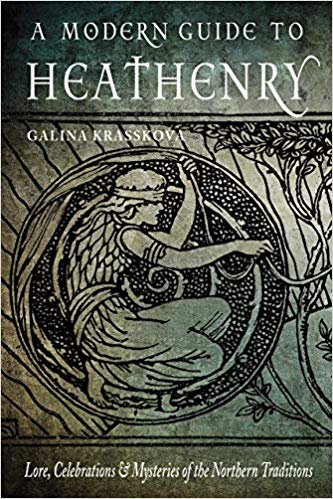
I have eagerly awaited publication of A Modern Guide to Heathenry: Lore, Celebrations & Mysteries of the Northern Traditions, Galina Krasskova’s revision of her seminal work, Exploring the Northern Tradition (issued in 2004), and find the new text to be a significant improvement on the book which introduced so many to Heathenism. Although long used pejoratively, the term ‘Heathen’ refers to the beliefs and spiritual traditions of the Scandinavian, German and Anglo Saxon peoples. Although still a small and relatively obscure faith, Heathenry is presently undergoing robust growth, thanks in part to popular culture and increased interest in pre-Conversion Northern European tribal society…
The author, who holds MAs in Religious Studies from New York University and Medieval Studies from Fordham University, is currently pursuing a PhD. in Theology at Fordham. In this revision, she beautifully frames a polytheist faith rooted in the past but vibrantly alive today, and while honoring the works collectively referred to as ‘The Lore’, places those works in a solid historical context, beginning with an exploration of the development of modern Heathenry. Like Christianity, Heathenism has numerous traditions, the beliefs and practices of which range from broadly inclusive to regrettably exclusionary. Krasskova opens by offering a survey of the primary denominations and how they differ. This is followed up with a comprehensive exploration of the rather complex cosmology that forms the foundation of Heathen belief, followed up by introductions to some of the many deities revered in this tradition. The concept of Wyrd or Causality is beautifully explained, as is the rich and complex Heathen understanding of the Soul. While it might seem unlikely that the spiritual system and values of an ancient tribal culture would have value and merit today, Ms. Krasskova conveys otherwise, setting forth the core ethics and values that still find such relevance in our current world.
Having established a solid foundation, the author moves on to exploration of the rituals and sacred practices of Heathenry, rites such as the blót and symbel, and the calendar of Holy Tides which anchors practitioners in the rhythms of nature. Within this context, Ms. Krasskova invites the reader into deep and meaningful personal relationship with the Gods and Ancestors through the creation of personal shrines and altars, and devotional practices such as prayers, offerings and traditional meditation. The deep reverence and emphasis on piety which mark Krasskova’s work serve to make this so much more than a “How To” text. While there is a regrettable tendency by many modern Pagans and Heathens to desacralize , she reminds us of the devotion and reverence that were hallmarks of historical Heathenry and remain the beating heart of this faith today.